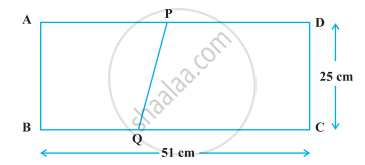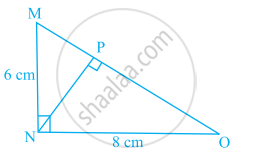Advertisements
Advertisements
Question
In the given figure, area of ΔPQR is 20 cm2 and area of ΔPQS is 44 cm2. Find the length RS, if PQ is perpendicular to QS and QR is 5 cm.

Solution
Given, area of ΔPQR = 20 cm2 and area of ΔPQS = 44 cm2
We know that,
Area of triangle = `1/2` × Base × Height
∴ Area of ΔPQR = `1/2` × PQ × QR ......[∵ PQ ⊥ QR]
⇒ 20 = `1/2` × PQ × 5
⇒ `(20 xx 2)/5` = PQ ......[∵ QR = 5 cm, given]
⇒ PQ = 8 cm
∴ Area of ΔPQS = `1/2` × PQ × QS
⇒ 44 = `1/2` × 8 × QS
⇒ QS = `(44 xx 2)/8` ......[∵ PQ = 8 cm]
⇒ QS = 11 cm
Now, RS = QS – QR = 11 – 5 = 6 cm
APPEARS IN
RELATED QUESTIONS
Find the area of a triangle whose vertices are A(3, 2), B (11, 8) and C(8, 12).
Prove that the points (2, – 2), (–3, 8) and (–1, 4) are collinear
The coordinates of A, B, C are (6, 3), (–3, 5) and (4, – 2) respectively and P is any point (x, y). Show that the ratio of the areas of triangle PBC and ABC is
Prove that the points (2a, 4a), (2a, 6a) and `(2a + sqrt3a, 5a)` are the vertices of an equilateral triangle.

In Figure 1, PS = 3 cm, QS = 4 cm, ∠PRQ = θ, ∠PSQ = 90°, PQ ⊥ RQ and RQ = 9 cm. Evaluate tan θ.
If the sides of a triangle are 3 cm, 4 cm and 5 cm, then the area is
Find the area of the triangle whose vertices are (-2, 6), (3, -6), and (1, 5).
Points A(3, 1), B(12, –2) and C(0, 2) cannot be the vertices of a triangle.
The dimensions of a rectangle ABCD are 51 cm × 25 cm. A trapezium PQCD with its parallel sides QC and PD in the ratio 9 : 8, is cut off from the rectangle as shown in the following figure. If the area of the trapezium PQCD is `5/6` th part of the area of the rectangle, find the lengths QC and PD.

In the given figure, ΔMNO is a right-angled triangle. Its legs are 6 cm and 8 cm long. Length of perpendicular NP on the side MO is ______.

